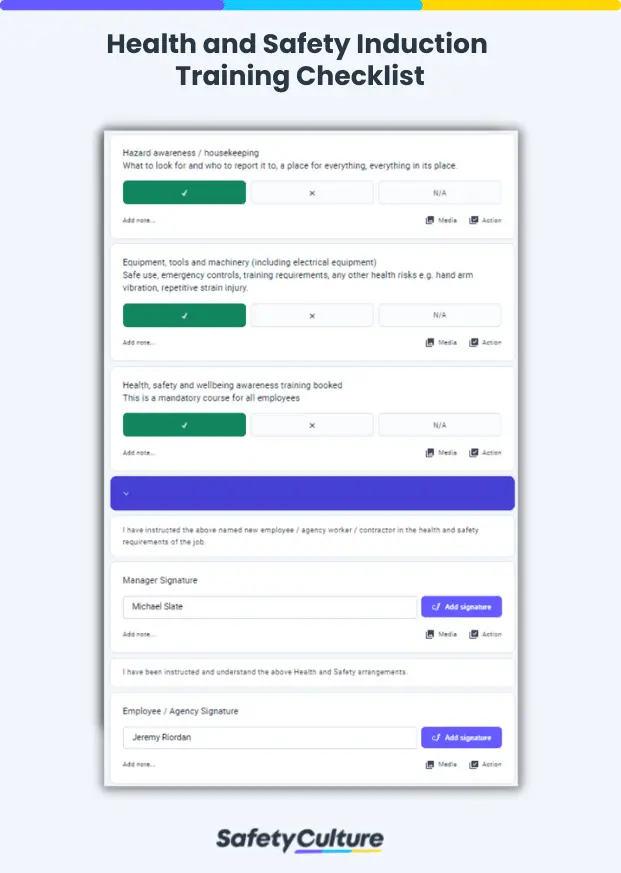What is a Safety Induction?
A safety induction is conducted to welcome new employees to the company and prepare them for their new role. It ensures workers are fully informed about the organization and are aware of their work and responsibilities, along with the risks and hazards that may come with their job. It also serves as a starting point for an organization to introduce a culture of safety in the workplace.
Why Conduct a Safety Induction?
Employees without proper safety inductions tend to have a higher tendency for negligence or non-adherence to health and safety regulations. Moreover, these workers are also prone to injuries and fatalities because of misinformation or inadequate knowledge to properly deal with hazards in the workplace.
A proper site or safety induction can help your workplace achieve the following:
- Promote a safe working environment for all employees.
- Help employees understand the values and behavior of the workplace culture.
- Ensure adequate knowledge of emergency procedures such as emergency exits, evacuation instructions and assembly points.
- Proper training on first aid and emergency protocols.
- Proper equipment handling.
- Understanding of critical government rules and regulations.
- Help employees transition smoothly to the organization and adjust to the new role.
- Workers know their work responsibilities and limitations.
- Employees are educated about company policies against bullying, harassment, and other critical policies.
- Employees rights and benefits are in place.
- Drive improvement in productivity and quality of work.
Create Your Own Safety Induction Checklist
Eliminate manual tasks and streamline your operations.
Get started for FREEHow is Health and Safety Induction Training Done?
A health and safety induction training is provided for new employees. Safety induction trainings can help new employees become familiar with their work activities, responsibilities, their colleagues or teammates, and operating policies, procedures, and rules. The topics covered in a health and safety induction training will vary depending on the employee’s role.
To conduct an effective induction training, trainers, safety officers, or authorized personnel must first choose the topics that will be covered in the training.
Below are some of the common safety induction topics that can be covered during a safety induction training session:
- Hazards and risks in your workplace
- Special equipment, such as personal protective equipment (PPE), which may require additional training
- Safe work practices
- Work health and safety legislation
- Emergency procedures
- First aid and other emergency contacts.
After that, they can proceed with the safety induction training, bearing in mind the tips below.
Effective Safety Induction Tips
The following tips and methods can help you conduct more effective safety inductions in your workplace:
- Set aside some time to do the induction. It may be done individually or with a new group of workers before reporting to work.
- Find a good location away from noise and distraction.
- Don’t rush it or try to spin it out, set an even pace.
- Make eye contact and ensure that everyone can hear you.
- Grab attention early on
- Be mindful of literacy and make sure that the workers understand what is required.
- Be confident but avoid confrontation
- Keep it simple. Be careful to ensure the messages you are sending are understood by the participants.
- Explain employees work requirements and safety directions
- Stress prevention and give examples of ignition sources.
- Keep a record of content and attendees
- Use a mobile safety induction software or inspection app to keep track of induction steps and record-keeping
Achieve operational excellence
Cultivate a culture of excellence with our digital solutions that enhance efficiency, agility, and continuous improvement across all operations.
Explore nowFAQs About Safety Induction
The three stages and processes of induction are pre-induction, induction, and post-induction. The pre-induction occurs prior to the first day of the employee and covers areas such as scheduling and equipment-related materials The induction stage, as the name suggests, is the actual delivery of the safety induction program. Lastly, the post-induction involves an evaluation aiming to ensure that the new employee has a good understanding of the information presented.
Some examples of common topics to cover during safety inductions are hazards and risks in the workplace, safe work practices, emergency procedures, injury management, and necessary PPEs, among others. These topics can further be customized according to the role of the employee to be inducted.
Ideally, any person who is new to a workplace needs to attend a safety induction—this includes employees, contractors, volunteers, and visitors. It is also recommended that employees be equipped with regular refresher courses to ensure that everyone is aligned with any changes to the safety procedures and aware of any possible hazards in the workplace.
Yes, in most organizations, HR (Human Resources) is responsible for coordinating and delivering the induction program. However, the responsibility for induction may also be shared by other departments, such as L&D (learning and development), health and safety, operations, or management.





